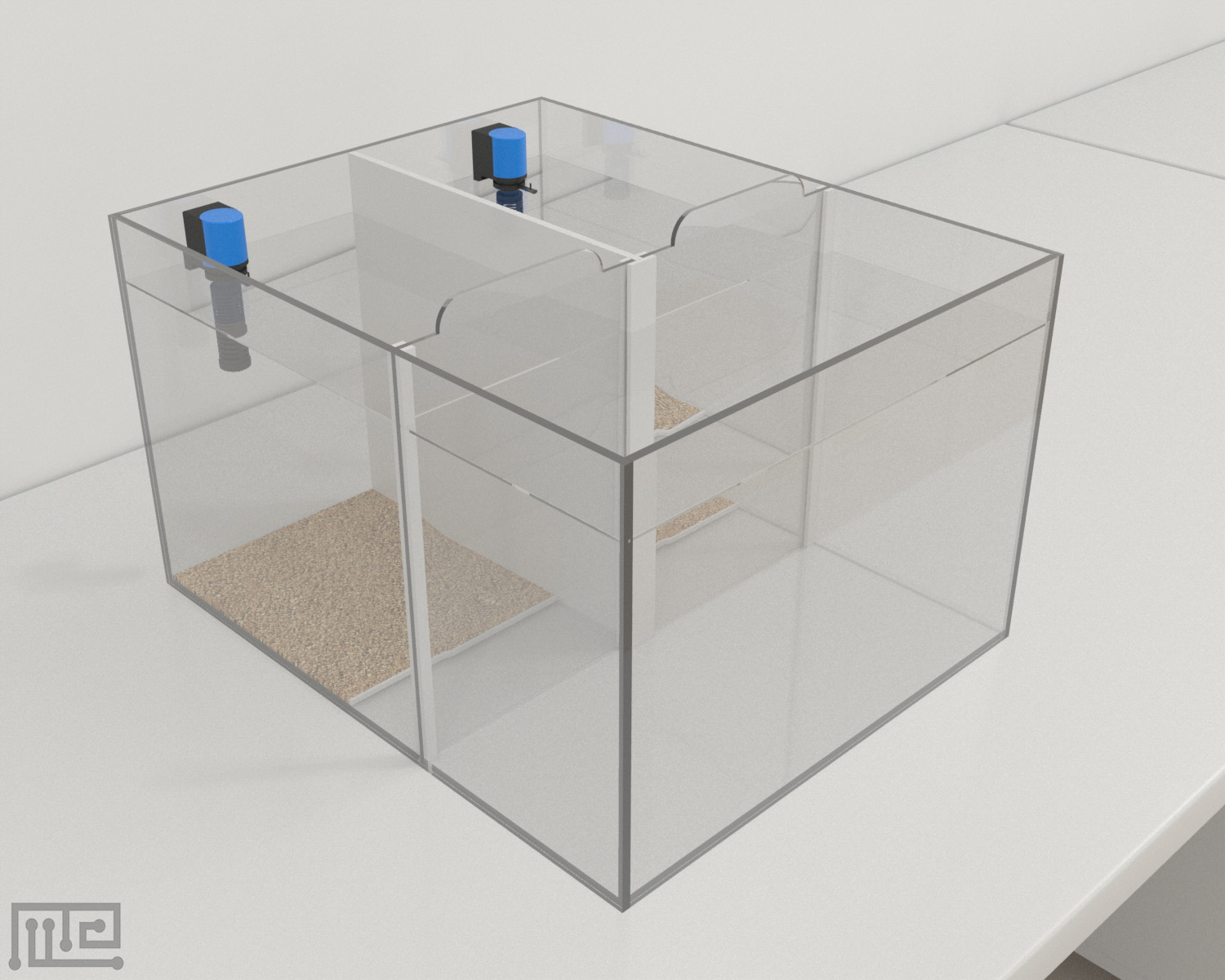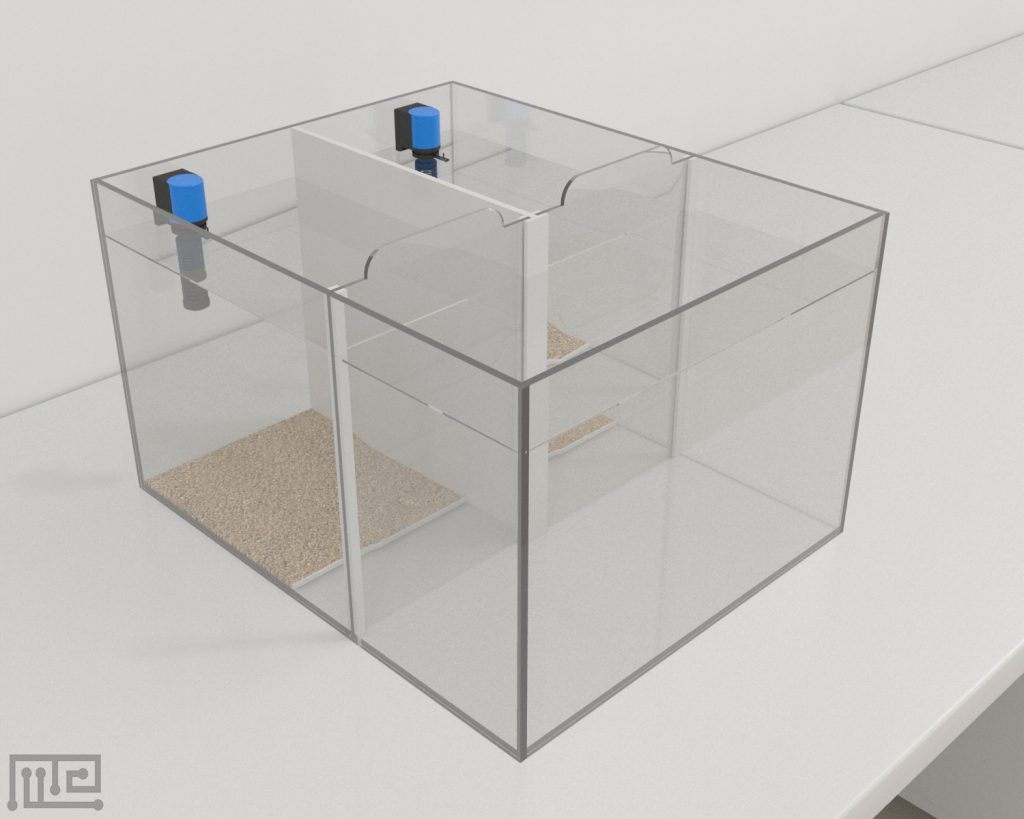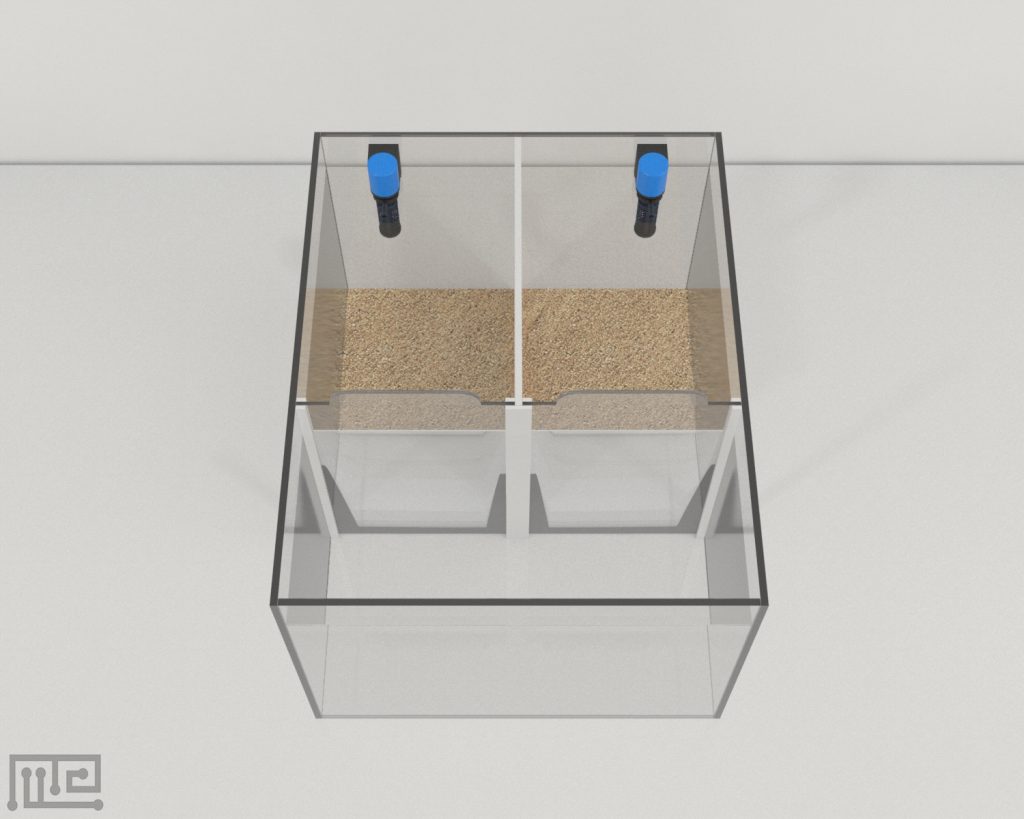The 5 Rectangular Tanks Maze was used by P. D. Boulcott et al.(2005), to test for the role of ultraviolet wavelengths in the mate-choice decisions of female threespined sticklebacks.
The experimental apparatus consisted of five rectangular tanks, each divided by an opaque plastic partition into three sections: a central viewing chamber and two adjacent choice chambers.
Mazeengineers offer the 5 Rectangular Tanks Maze.
Price & Dimensions
5 Rectangular Tanks Maze
$ 1990
+S&H- Length of rectangular tanks: 45cm
- Width of rectangular tanks: 30cm
- Height of rectangular tanks: 30cm
Documentation
Introduction
The 5 Rectangular Tanks Maze is a behavioral apparatus designed to assess mate choice decisions in three-spined sticklebacks. A variety of vertebrates such as birds, lizards, and fish are reported to utilize ultraviolet (UV) radiations as a visual cue in making mate choice decisions (Hunt et al., 1997; Pérez I de Lanuza, & Font, 2014; Boulcott, Walton, & Braithwaite, 2005). Likewise, three-spined sticklebacks have also been found to respond to UV radiations when responding sexually toward courting males (Boulcott, Walton, & Braithwaite, 2005).
The 5 Rectangular Tanks Maze provides a simple environment to assess mate-choice decisions based on UV-based visual cues. The maze is a rectangle-shaped apparatus consisting of 5 tanks, each comprising of three chambers. There is one central chamber and two choice chambers provided with interchangeable UV transmitting and UV blocking filters. The female subject placed in the central chamber responds to UV radiation and makes a mating choice with any of the two male subjects in the choice chambers. The 5 Rectangular Tanks Maze can be used to evaluate UV-based mate choice decisions. It can also be used in vision and retina research in three-spined sticklebacks.
Other apparatuses for the assessment of different behaviors in fish include the Zebrafish Rotation Test, the Zebrafish Associative Learning, the Zebrafish T Maze, the Bifurcating T Maze, and the Larvae T-Maze.
Apparatus and Equipment
The 5 Rectangular Tank Maze is made of plexiglass and comprises of 5 rectangular tanks (50 cm x 40 cm x 30 cm). Each tank is partitioned into three chambers with the help of opaque plastic dividers. The choice chambers are sealed from the central chamber with watertight UV transmissive plexiglass. The central chamber serves as a female viewing chamber, while the two adjacent chambers serve as choice chambers. The partition between the central chamber and the adjacent chambers is provided with interchangeable UV transmitting and UV blocking filters creating two choices for the subject. The female viewing chamber has two zones: the non-preference zone and the preference zone (within 5 cm of each filter type).
Training Protocol
Clean the apparatus before each trail to avoid residual olfactory cues. Properly lit the apparatus. Conduct trails during the daytime. The Noldus Ethovision XT can be used as a video tracking system to record observations.
Filter preference task
Take the subject from its home tank and place it in the non-preference zone of the female viewing chamber. Allow it to acclimatize for 10 minutes. Start the trail by removing the plexiglass screen and record the preference of the subject for the filter type once the subject’s head and pectoral fins had crossed the zone boundary. After 20 minutes, remove the subject and place it back into its home tank. Conduct 10 trials.
UV perception and shoaling behavior task
Take the female subject from its home tank and place it in the non-preference zone of the female viewing chamber. Allow it to acclimatize for 10 minutes. Now place a non-reproductive male stimulus in each of the two choice chambers. Start the trail by removing the plexiglass screen and record the subject’s preference toward non-reproductive male stimulus for 20 minutes. Conduct 10 trials.
Gravid female filter preference task
Take the gravid female subject from its home tank and place it in the non-preference zone of the female viewing chamber. Now place the non-reproductive male stimulus one in each choice chamber. Allow them to acclimatize for 10 minutes. Start the trial by removing the plexiglass screen and allow the subject to make a preference towards reproductive male stimulus by recording the head-up position of the gravid female subject for 20 minutes. Conduct 10 trials.
UV perception and mate choice task
Take the gravid female subject from the home tank and place it in the female viewing chamber. Place sexually reproductive male stimuli in the two choice chambers and provide them with nesting material to make a nest. Once they create the nest and start courting vigorously with the female subject, remove the plexiglass screen to initiate the trial. Record the zig-zag movement of the male stimulus for 20 minutes. Conduct 10 trials.
Literature Review
Investigating the role of UV radiation on mate choice behavior of female Gasterosteus aculeatus L
Boulcott, Walton, & Braithwaite, 2005 investigated the role of UV radiation on the mate choice behavior of female Gasterosteus aculeatus L. The mate choice behavior was carried out using the Rectangular 5 tank task. The study involved five groups: the Non-reproductive female group (n=10), the Non-reproductive male group (n=10), the Gravid female group (n=10), and the Reproductive male group. Four experiments were carried out: which involved four tasks to analyze non-reproductive and gravid female preference towards UV transmitting and UV blocking filters (Controls) and UV perception mediated shoaling behavior and mate choice task. The results of the study showed that both gravid females (P>0.05), along with non-gravid females (P>0.05), do not show a preference for either of the two filter types. Also, no significant effect of the holding tanks (p>0.05) was observed for both females. It was observed that females didn’t show preference for reproductive male conspecifics presented through either of the UV transmitting or UV blocking filters (t=–1.27, P<0.05). Also, no significant holding tank effect and difference in time spent in the preference zone were observed compared to controls (p>0.05). The results of the mate choice task revealed that gravid females showed significant preference to the males presented through UV transmitting filters (t=3.88, p<0.05). They also spent more time in the UV transmitting filter preference zone (t=–4.46, P<0.001). This research concluded that female Gasterosteus aculeatus make mate choices based on UV-based visual cues.
Data Analysis
- The proportion of time the female subject preferred UV transmitting filter preference zone
- The proportion of time the female subject preferred UV blocking filter chamber preference zone
- Zig zag movement of reproductive male stimulus in response to the gravid female subject
Strengths and Limitations
Strengths
The task performance in the 5 Rectangular Tanks Maze is easy and does not require pretraining of the subjects. The presence of the watertight plexiglass screen between the central and the adjacent chambers aids in preventing surrounding olfactory cues. The apparatus is multi-chambered but very easy to assemble.
Limitations
The task performance requires multiple handling of the subjects, which makes the task tiresome. The surrounding visual cues may alter observations; however, they can be minimized by covering the apparatus with a black sheet during the trail. The age, size, and specie of the subject may influence observations.
Summary
- The 5 Rectangular Tanks maze is a multi-chamber task designed to assess mate choice decisions in the three-spined sticklebacks.
- The apparatus consists of 5 tanks; each tank is divided into three chambers.
- The partition between the central and the adjacent chambers is provided with UV transmitting and UV blocking filters.
- The female subject placed in the central chamber responds to UV radiation and makes a mating preference towards male stimulus presented through UV transmitting filters.
- The task is easy to perform and doesn’t require the pretraining of the subjects.
- Apart from the assessment of mating choices, the 5 Rectangular Tanks maze can be utilized in vision and retina research.
References
- Boulcott, P. D., Walton, K., & Braithwaite, V. A. (2005). The role of ultraviolet wavelengths in the mate-choice decisions of female three-spined sticklebacks. The Journal of experimental biology, 208(Pt 8), 1453–1458. https://doi.org/10.1242/jeb.01569
- Hunt, S., Cuthill, I. C., Swaddle, J. P., & Bennett, A. (1997). Ultraviolet vision and band-colour preferences in female zebra finches, Taeniopygia guttata. Animal behaviour, 54(6), 1383–1392. https://doi.org/10.1006/anbe.1997.0540
- Pérez i de Lanuza, G., & Font, E. (2014). Ultraviolet vision in lacertid lizards: evidence from retinal structure, eye transmittance, SWS1 visual pigment genes and behaviour. The Journal of experimental biology, 217(Pt 16), 2899–2909. https://doi.org/10.1242/jeb.104281




